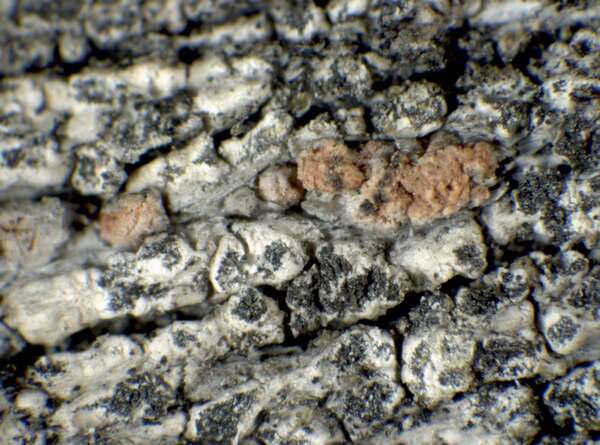Buellia arborea Coppins & Tønsberg
Sommerfeltia, 14: 111, 1992.
Synonyms:
Distribution: N - Frl.
Description: Thallus crustose, endosubstratic to thinly episubstratic and areolate, whitish, forming orbicular, up to 4 cm wide patches, sometimes delimited by a very thin, pale prothallus, sorediate. Areoles sparse, discrete or contiguous, becoming more or less convex, usually esorediate. Medulla white, I-. Soralia bursting through the cell-layers of the bark or wood, often delimited by a thin, lacerate rim of bark cells, pale green to bluish green, but frequently darkened and brownish to blackish, orbicular to ellipsoid-elongate, flat to crateriform, up to 0.4 mm across, bearing farinose, up to 30 µm wide soredia which are strongly inspersed with crystals dissolving in K. Apothecia rare, lecideine, black, 0.2-0.5 mm across, initially more or less immersed, then sessile, with a concave to finally flat disc, and a thin, usually persistent proper margin. Proper exciple Dispersa-type, of radially arranged hyphae, the inner part of long-celled, parallel, strongly agglutinated and thick-walled hyphae, the outer part of short-celled, isodiametrical hyphae without intercellular spaces; epithecium olive-brown, N-; hymenium colourless, up to 120 µm high, strongly inspersed with oil droplets; paraphyses simple or sparingly branched, 1.5-2 µm thick at mid-level, the apical cells 4-5 µm wide, with a brown cap; hypothecium deep reddish brown. Asci 8-spored, clavate to cylindrical-clavate, the apical dome K/I+ dark blue with a pale, conical-pointed apical cushion (axial mass), the wall I-, but the thin outer gel I+ blue, Bacidia-type. Ascospores 1(-3)-septate, soon brown, narrowly ellipsoid, usually not constricted at septum, with pointed and often paler ends, sometimes slightly curved, 18-28 x 7.5-12.5 µm, Callispora-type. Photobiont chlorococcoid. Spot tests: thallus K+ yellow, C-, KC-, P- or P+ yellow, UV-; soralia K- or K+ faintly yellow (squash preparations). Chemistry: atranorin, placodiolic acid.Note: a usually sterile species with bluish-greenish, round to elongated, and flat to concave soralia reacting K- in squash preparations; usually found on periodically dry wood of logs and old fences in upland areas; certainly more widespread in the Alps, and locally rather common, but often overlooked.
Growth form: Crustose
Substrata: lignum
Photobiont: green algae other than Trentepohlia
Reproductive strategy: mainly asexual, by soredia, or soredia-like structures (e.g. blastidia)
Commonnes-rarity: (info)
Alpine belt: absent
Subalpine belt: rare
Oromediterranean belt: absent
Montane belt: rather rare
Submediterranean belt: absent
Padanian area: absent
Humid submediterranean belt: absent
Humid mediterranean belt: absent
Dry mediterranean belt: absent

Predictive model
Growth form: Crustose
Substrata: lignum
Photobiont: green algae other than Trentepohlia
Reproductive strategy: mainly asexual, by soredia, or soredia-like structures (e.g. blastidia)
Commonnes-rarity: (info)
Alpine belt: absent
Subalpine belt: rare
Oromediterranean belt: absent
Montane belt: rather rare
Submediterranean belt: absent
Padanian area: absent
Humid submediterranean belt: absent
Humid mediterranean belt: absent
Dry mediterranean belt: absent

Predictive model
 INDEX FUNGORUM
INDEX FUNGORUM
 GBIF
GBIF
 DOLICHENS
DOLICHENS



